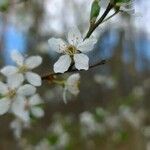Shrubs, rarely trees, 4–8 m tall. Branches reddish brown, robust, glabrous, spiny; branchlets reddish brown, densely pubescent. Winter buds purplish red, pubescent. Stipules lanceolate, margin glandular, apex acuminate. Petiole 5–7 mm, pubescent, without nectaries; leaf blade oblong-obovate, elliptic-ovate, or rarely oblong, 2–4 × 0.8–1.8 cm, abaxially yellowish green and pubescent, adaxially dark green and sparsely appressed pubescent, glabrescent, base subrounded to broadly cuneate, margin crenate or sometimes doubly crenate, apex acute to obtuse; secondary veins 4 or 5(–8) on either side of midvein. Flowers solitary, opening before leaves, 1–1.5 cm in diam. Pedicel 6–8(–15) mm, glabrous or sparsely pubescent. Hypanthium outside glabrous. Sepals triangular-ovate, outside glabrous, margin serrulate, apex acute. Petals white with pale purple veins, oblong, base cuneate, apex obtuse. Stamens 20–25. Ovary glabrous. Stigma capitate. Drupe black, globose, broadly ellipsoid, or conical, 1–1.5 cm in diam., glabrous, glaucous; mesocarp green; endocarp brown, ovoid to ellipsoid, ± flattened, rugose. Fl. Apr, fr. Aug.
More
Shrubs, suckering, 10–40 dm, thorny. Twigs with axillary end buds, hairy. Leaves deciduous; petiole 4–7 mm, hairy, eglandular; blade elliptic to obovate, 1.5–4 × 1–2.2 cm, base obtuse to rounded, margins crenulate-serrulate, teeth blunt, often glandular, apex acute to obtuse, abaxial surface hairy (especially along midribs and veins), adaxial glabrate. Inflorescences usually solitary flowers, sometimes 2-flowered fascicles. Pedicels 0.5–5(–8) mm, usually glabrous, rarely hairy. Flowers blooming before leaf emergence; hypanthium cupulate, 1.5–2.5 mm, glabrous externally; sepals spreading, oblong, 1.5–2.5 mm, margins glandular-toothed, surfaces glabrous or adaxially hairy at bases; petals white, elliptic, 4–8 mm; ovaries glabrous. Drupes bluish black, globose, 10–15 mm, glabrous; mesocarps fleshy; stones subglobose, ± flattened. 2n = 32.
Hedgerows and woods, usually in sunny positions, on all soils except acid peats. Mostly in the forest-steppe zone, glades, forest edges, ravines, river valleys; rarely inside forest; at elevations from 800-1,200 metres.













